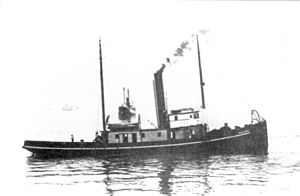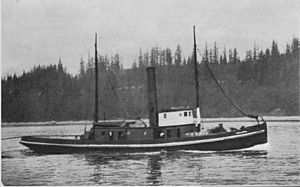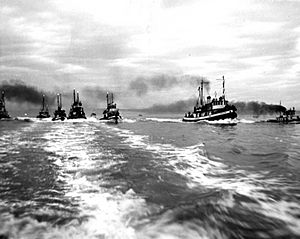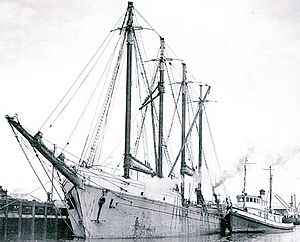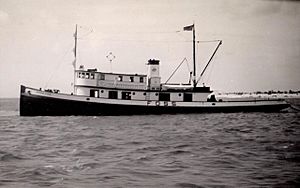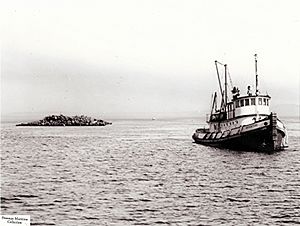Arthur Foss facts for kids
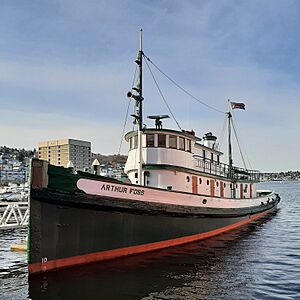
Arthur Foss in her slip at the Historic Ships Wharf at Lake Union Park, March 2021.
|
|
| History | |
|---|---|
| Name |
|
| Owner |
|
| Builder | Willamette Iron and Steel Works |
| Launched | Summer 1889 |
| In service | Fall 1889 |
| Out of service | Summer 1968 |
| Identification |
|
| Status | Museum Ship |
| Notes | Believed to be world's oldest wooden tug afloat |
| General characteristics | |
| Type | Tugboat |
| Tonnage |
|
| Displacement | 583 tons (unloaded) |
| Length | 120 ft (37 m) |
| Beam | 24.5 ft (7.5 m) |
| Height | 45 ft (14 m) |
| Draft | 16.0 ft (4.9 m) |
| Decks | 4 |
| Installed power | Washington Iron Works diesel, direct reversing 6 cylinder, 700 hp (520 kW), 18,382 lb⋅ft (24,923 N⋅m) |
| Propulsion | Direct-drive to 6 ft (1.8 m) diameter 3-blade propeller |
| Speed | 13 kn (24 km/h; 15 mph) |
| Crew | 7 (inshore tows) to 9 (coastal and oceanic tows) |
| Notes | Classic heavy wood construction with limited ice-breaking capacity |
|
Arthur Foss (tugboat)
|
|
| Location | Historic Ships Wharf, 860 Terry Avenue N., Seattle |
|---|---|
| Area | Lake Union Park, South Lake Union, Seattle |
| Built | 1889, Portland, Oregon |
| Architect | David Stephenson |
| Architectural style | Sawn old-growth Douglas fir, plank on frame |
| NRHP reference No. | 89001078 |
| Significant dates | |
| Added to NRHP | 11 April 1989 |
| Designated NHL | 11 April 1989 |
The Arthur Foss is a famous old tugboat built in 1889 in Portland, Oregon. It was first named Wallowa. Many people believe it's the oldest wooden tugboat still floating in the world!
This tugboat worked for 79 years, helping ships and moving logs. It started by pulling sailing ships over the tricky Columbia River bar. Later, it moved huge rafts of logs on the Strait of Juan de Fuca. Today, the Northwest Seaport organization keeps the Arthur Foss as a museum ship in Seattle, Washington.
The tugboat had an exciting life, including a big role in the Klondike Gold Rush. It also had a dramatic escape during World War II. In 1941, it was helping build airfields on Wake Island when war warnings started. The captain quickly left without refueling. Just 12 hours later, they heard about the attack on Pearl Harbor. The crew quickly repainted the tug and stayed silent on the radio. They made it safely to Pearl Harbor, but with very little fuel left. The Navy then used the tug during the war, calling it Dohasan. After the war, it returned to its original name and continued working for many more years.
Contents
Building a Powerful Tugboat
The Wallowa was built in 1889 for a company called the Oregon Railway & Navigation Company. A skilled ship designer named David Stephenson created its hull. The Willamette Iron and Steel Works built the boat.
The tugboat was about 120 feet (36.6 meters) long. It had powerful steam engines taken from an older tug. In September 1889, the Wallowa made its first trip down the Columbia River. Everyone agreed it was perfect for its job.
The Wallowa's first captain was R.E. Howes. His job was to tow sailing ships across the dangerous sandbar at the mouth of the Columbia River. This was a very important and risky job, and the Wallowa did it well for nine years.
Adventures in the Klondike Gold Rush
In 1898, many people rushed to Alaska for the Klondike Gold Rush. This meant lots of ships were needed. The Wallowa was leased to the White Star Line to tow a big ship called Yosemite to St. Michael, Alaska. This town was a main entry point to the gold fields.
During one trip back to Seattle, a huge storm hit. The tugboat was pushed ashore near Mary Island in Alaska. Luckily, the Wallowa wasn't damaged and floated free with the next high tide. Its strong build helped it survive many stormy trips.
The Wallowa made many more trips up the Inside Passage. It carried supplies and building materials for the mining camps. By 1903, the tug returned to Puget Sound and started a new job in the timber industry.
Working for the Timber Industry
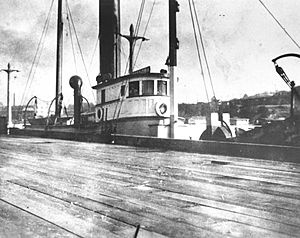
In 1904, a lumber boss named Mike Earles bought the Wallowa. His company, Puget Sound Mill & Timber Company, used the tug for the next 25 years. Its main job was to tow huge log rafts from the Olympic Peninsula to sawmills in Bellingham.
Mike Earles gave the Wallowa a big upgrade. He installed a new boiler and a more powerful steam engine. This made the tugboat much stronger for towing. It worked reliably, except for a time in 1927 when its main deckhouse had to be rebuilt after a fire.
In 1929, the Wallowa was sold to another timber company, Merrill & Ring Logging Company. It continued towing logs, but after less than a year, they decided to sell the tug.
The Arthur Foss Becomes a Movie Star
The Foss Launch & Tug Company bought the Wallowa in late 1929. To help pay for it, Foss leased the tug to MGM Studios. The tugboat starred in the 1933 movie Tugboat Annie! This movie was a huge hit and made the Wallowa (unofficially called "Narcissus" in the film) a movie star.
After its movie career, Foss rebuilt and modernized the tug in 1934. They installed a brand-new, powerful diesel engine. This made the tugboat the strongest on the West Coast. Foss then renamed the tug Arthur Foss, honoring the company president.
The Arthur Foss became the main ship for the Foss company. It set records for speed and how much it could tow. In 1936, it towed a huge lumber schooner from Oregon to Los Angeles in a record seven days, even in bad weather.
In 1937, a fire broke out in the crew's sleeping area. To save the tug, the captain bravely steered it into shallow water and sank it to put out the fire. The Arthur Foss was later refloated and repaired.
The Arthur Foss also helped build famous bridges. In 1938, it towed a giant barge used for the Golden Gate Bridge to help build the Tacoma Narrows Bridge. It also helped test the design for the Lacey V. Murrow Memorial Bridge, a floating bridge on Lake Washington. The tug created huge waves and pushed against a test barge to make sure the bridge design was strong enough.
In early 1941, the Arthur Foss left for Oakland, California, to pick up a huge gate for a dry dock at Pearl Harbor. It delivered the gate to Hawaii two weeks later, thinking it was just another routine job.
World War II Heroics
After delivering the drydock gate, the Arthur Foss was hired to help build military bases on Pacific islands, including Wake Island. It towed barges of building materials and supplies. In November 1941, the tug was at Wake Island with another smaller tug, Justine Foss.
As war tensions grew, the captain of the Arthur Foss decided to leave Wake Island quickly, even without refueling. Twelve hours into their trip, they heard the shocking news: Pearl Harbor had been attacked! The Japanese also attacked Wake Island.
The Arthur Foss was painted a bright white and green, making it an easy target. The crew quickly mixed all the white paint they had with engine grease to repaint the tug dark gray. They turned off their radio and sailed quietly. They were unsure if they had enough fuel to reach Hawaii or if the enemy would be there. They decided to head for Honolulu at a slower speed to save fuel.
On December 28, 1941, the Arthur Foss was spotted by U.S. Navy planes and safely escorted into Pearl Harbor. They were a week late and had been thought lost. They arrived with less than a day's worth of fuel left!
The Arthur Foss was the last ship to escape Wake Island before Japanese forces captured it. Sadly, the crew of the Justine Foss, who stayed to refuel, were captured. Most of them were later executed.
The United States Navy took over the Arthur Foss in 1942. They renamed it Dohasan and used it as a harbor tug. It towed supply barges around Hawaii and even helped build an emergency landing strip far out in the ocean. After the war ended in 1945, the tug was returned to Foss in 1947 and renamed Arthur Foss again. It needed a lot of repairs after its wartime service.
Back to Work and Retirement
After its repairs, the Arthur Foss went back to work in 1948. Its job was to tow huge bundled log rafts in the Strait of Juan de Fuca. It did this for 20 years, setting a record for the longest continuous towing service in the Straits.
In 1964, the tug was renamed Theodore Foss for a few years. A brand-new tugboat took the name Arthur Foss. But when the old tug retired in 1968, it was donated to Northwest Seaport in 1970 and got its original name, Arthur Foss, back.
A National Historic Landmark Today
Today, the Arthur Foss is a National Historic Landmark and a Seattle Landmark. It's also on the National Register of Historic Places. In 1989, it was named a Washington State Centennial Heritage Flagship, celebrating its 100th birthday along with the state.
Volunteers at Northwest Seaport worked hard to clean and fix up the tugboat. In 1980, its main engine was started up again as a museum ship. For many years, the Arthur Foss cruised the waters of Puget Sound, taking part in tugboat races and boat shows.
The Arthur Foss is currently docked at the Historic Ships Wharf at Seattle's Lake Union Park. You can visit it for public tours on most summer weekends or by appointment. It's a great chance to see what life was like on one of America's oldest and most historic ships!
See also


